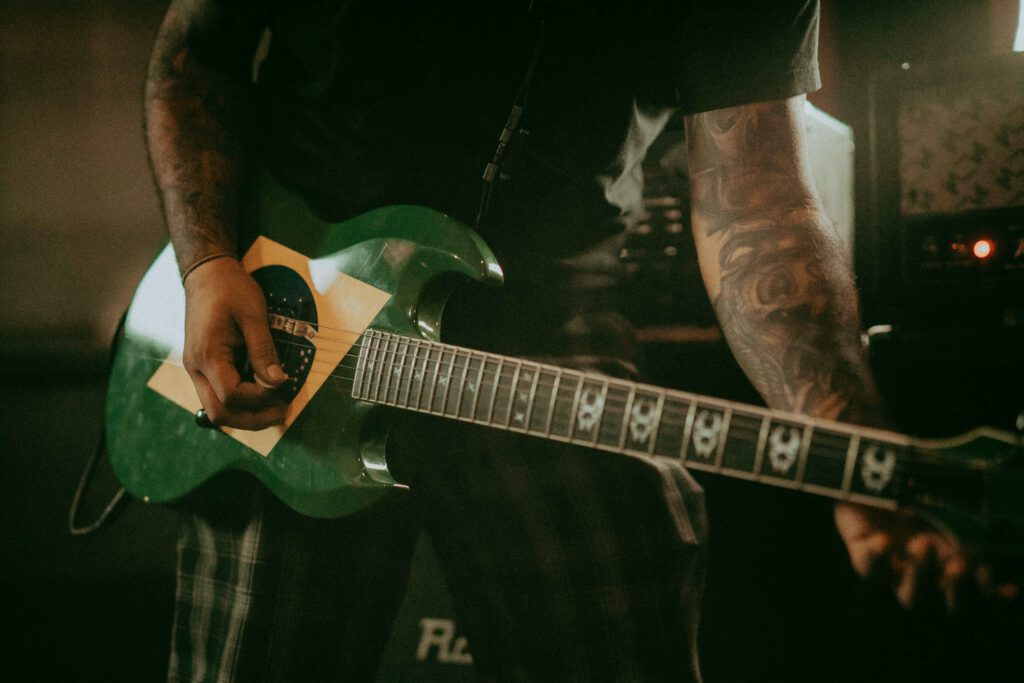Neoclassical guitar has stood as one of the most technically demanding and compositionally rich branches of rock and metal. Fusing baroque and classical influences with electric guitar virtuosity, the style has produced a group of highly influential players whose work continues to inspire new generations. Below is a look at ten of the most important figures in this field, chosen for their technical innovation, compositional brilliance, and lasting influence.
Yngwie Malmsteen
No discussion of neoclassical guitar can begin without Yngwie Malmsteen. Emerging in the early 1980s, he reshaped what was possible on the electric guitar with his speed, sweep picking, and mastery of harmonic minor scales. His debut album Rising Force set the standard for the genre, establishing the now-classic blend of Bach-like arpeggios and high-gain metal tone. Malmsteen is known for his relentless dedication to precision and drama, often composing pieces that sound closer to orchestral suites than typical rock songs. His influence is so pervasive that many players either emulate his style directly or measure themselves against it.
Jason Becker
Jason Becker displayed a rare combination of speed, phrasing, and compositional depth. His work with Marty Friedman in the band Cacophony introduced twin-guitar neoclassical shred to a wider audience. At just 19, he released Perpetual Burn, an album often cited as one of the finest in instrumental shred history. Tragically, Becker was diagnosed with ALS at 20, cutting short his performance career, but his legacy remains powerful. Even from his wheelchair, he has continued to compose music with the aid of computer technology, proving his creative mind remains unbroken.
Marty Friedman
Marty Friedman’s neoclassical approach has always carried a distinctive twist. While rooted in harmonic minor and exotic scales, he often drew from Eastern tonalities, giving his solos an unmistakable voice. His partnership with Jason Becker in Cacophony pushed shred guitar into new compositional territory, and his later work with Megadeth on albums like Rust in Peace brought neoclassical ideas to mainstream metal audiences. Friedman’s phrasing is less about sheer speed and more about unusual note choices and bends that mimic traditional instruments of other cultures, making him a unique figure in the genre.
Tony MacAlpine
Tony MacAlpine is a multi-instrumentalist who has bridged neoclassical guitar and classical piano. His debut album Edge of Insanity remains a cornerstone of shred, filled with blistering solos, intricate harmonies, and classical etudes. Beyond his solo work, MacAlpine collaborated with virtuosos such as Steve Vai and Vinnie Moore, solidifying his reputation as a technical giant. His ability to balance technical ferocity with compositional sophistication separates him from many players who rely solely on speed. His piano skills often inform his guitar writing, giving his neoclassical compositions a more authentic classical texture.
Vinnie Moore
Vinnie Moore emerged in the mid-1980s during the height of shred’s popularity. His album Mind’s Eye is often cited as one of the most musically balanced examples of neoclassical shred, mixing technical precision with memorable melodies. Moore’s career extended beyond solo albums, as he later joined UFO, where he displayed adaptability by applying his neoclassical skills in a hard rock context. His style is marked by clean alternate picking, sweeping arpeggios, and carefully structured compositions that lean heavily on classical motifs. Moore has influenced countless players with his balance of flash and musicality.
Paul Gilbert
While often associated with his work in Racer X and Mr. Big, Paul Gilbert has a significant place in neoclassical guitar. In Racer X, he combined blinding speed with Bach-like sequences and highly articulate picking, creating one of the tightest shred sounds of the 1980s. His instructional videos further spread neoclassical technique to a generation of guitarists. Although his later career leaned more toward rock and blues, his early neoclassical shred remains essential listening. Gilbert’s clarity of execution, particularly in string skipping and alternate picking, set benchmarks for technical discipline.
Michael Romeo
Michael Romeo, founding guitarist of Symphony X, brought neoclassical shred into the progressive metal arena. His playing blends baroque-inspired riffs with complex time signatures, orchestral arrangements, and heavy riffing. Albums like The Divine Wings of Tragedy and V: The New Mythology Suite showcase his ability to write epic compositions where neoclassical guitar serves the larger structure of concept albums. Romeo’s precision, sweep picking, and mastery of arpeggios make him a modern giant of the genre, influencing both shredders and progressive metal musicians alike.
Ritchie Blackmore
Although he predates the shred explosion of the 1980s, Ritchie Blackmore deserves recognition as a progenitor of neoclassical guitar. With Deep Purple and later Rainbow, he incorporated Bach-like runs and baroque sequences into rock riffs, laying the foundation for the genre. Tracks like “Highway Star” showcased fast scalar runs that directly inspired Malmsteen and others. Blackmore’s importance lies in how he bridged blues-based rock with classical phrasing, making him one of the earliest guitarists to pursue neoclassical ideas seriously on the electric guitar.
Uli Jon Roth
Uli Jon Roth, a former member of Scorpions, pushed rock guitar into neoclassical territory before it became a recognized subgenre. His compositions incorporated overtly classical structures, and he later developed the “Sky Guitar,” an instrument with extended range to better capture violin-like phrasing. Roth’s influence can be heard in later virtuosos who cite his pioneering approach to scale choices, vibrato, and phrasing. While less commercially known than Malmsteen, Roth was instrumental in planting the seeds of the neoclassical movement and inspiring a generation of shredders.
Chris Impellitteri
Chris Impellitteri is often celebrated for his unmatched picking speed and technical clarity. Leading his band Impellitteri, he built a reputation as one of the fastest guitarists in the world while firmly rooted in the neoclassical tradition. His albums combine blistering solos with high-energy riffs and strong melodic sense. While sometimes overshadowed by Malmsteen in public recognition, Impellitteri’s consistency and dedication to neoclassical shred make him one of its most respected practitioners. His work is characterized by rapid alternate picking, sweeping arpeggios, and intricate harmonized passages that highlight his deep classical influence.
Lasting Legacy of Neoclassical Guitarists
These ten guitarists represent both the origins and the evolution of neoclassical guitar. From Ritchie Blackmore’s early experiments to Michael Romeo’s progressive fusions, the style has expanded far beyond the 1980s shred explosion. Central to all of them is the merging of centuries-old classical traditions with the modern electric guitar, producing music that is both technically demanding and compositionally rich. Their legacies endure not just in recordings but in the thousands of players worldwide who continue to study their techniques.




